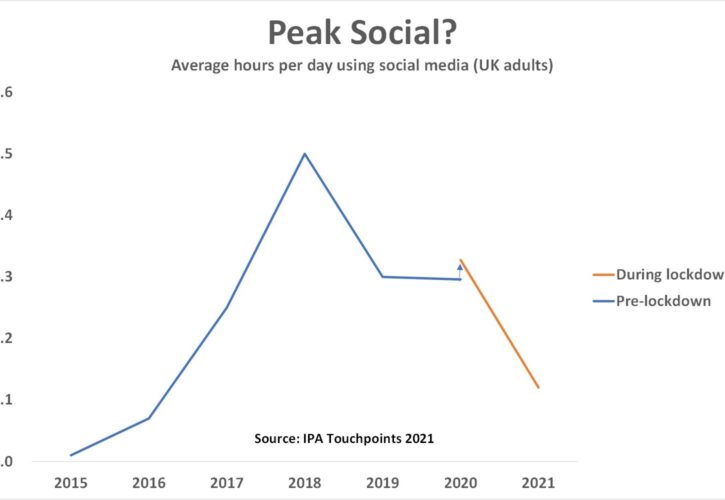
Have we reached Peak Social? If so, what’s next?
Have we reached Peak Social?
Advertising legend Les Binet (of Binet & Field fame) recently shared the above image on Linkedin, asking if we had reached ‘Peak Social’:
It sparked a lively debate on Linkedin and got us thinking hard about whether social is really in decline.
The data, sourced from the IPA, is pretty convincing; it shows that Brits are spending 25% less time on social media than they did 3 years ago.
But one graph almost never tells the whole story.
So to see if Binet’s theory was right, we needed more data.
First off we dug into GWI for some data which could show the trends by market.

As the graph above shows, time spent on social media has been running pretty flat since 2016. However, the high time-spent in countries such as Brazil points to huge potential growth in emerging markets.
Perhaps even more interesting for advertisers than time-spent though is reach.
Hootsuite have estimated that half a billion new users joined social media in 2020, taking the total number to 4.48 billion – 57% of the world’s population. Sure, some of these users are bots or duplicates, but the total number and the consistent growth are both pretty staggering.
As the internet and smartphones continue to spread across the world it seems inevitable that social media will follow.
So even if time-spent per person is no longer increasing in developed countries, total global time spent on social media will continue to grow steadily.
A lot of people on the comment thread were asking what the data would look like split out by age, so heading back to the UK and the US (where most of our clients are right now) we’ve pulled that data as well.

For the younger groups, it looks like usage time has been declining amongst 25-44s since 2017, but it has been running pretty steady for 18-24s and 45-64s.
The slow tailing off of use amongst 25-34s is unsurprising considering that age group’s widespread disillusionment with social media. Only 26% of UK and US 25-34s think social media is good for society. 29% worry they spend too much time on social media and 22% feel it causes them anxiety.
So it does seem that Binet is right, social media consumption is flatlining in terms of time spent per user in mature markets.
But what’s been stealing attention as social media stands still?
Streaming is the big one, and it’s shown huge growth since 2017, the latest data from GWI shows that 63% of UK and US 16-64s have watched Netflix in the past month, and 55% have watched YouTube.
Gaming is also incredibly wide reaching, with 77% of this group playing a game on any device in the past month. This number goes up to 88% if we zero in on 16-24s.
Other app categories, such as Dating, Exercise and Investment have also imitated some of the stickiest product features of social media to take attention away from social media itself.
So what’s next for social?
Sure, TikTok is huge with Gen Z and has offered great opportunities to advertisers. But realistically it’s just Vine (remember Vine?) with a way better algorithm.
If you ask Mark Zuckerberg what the future of social media looks like, as The Verge recently did, he’ll tell you it’s all about the metaverse, which he believes will be the next phase of the internet.
I’ll let him explain the metaverse in his own words:
“You can think about the metaverse as an embodied internet, where instead of just viewing content — you are in it. And you feel present with other people as if you were in other places, having different experiences that you couldn’t necessarily do on a 2D app or webpage, like dancing, for example, or different types of fitness.”
The metaverse is a new vision for the internet which is far more immersive than what we currently have. It’s your work, your social life, your exercise, your everything – all linked together and instantly accessible, enabled by VR, AR and all of your devices.
Immersion is key. Instead of surfing the web, you’re swimming in it.
Interestingly, social media companies aren’t currently leading the way when it comes to the metaverse. Games like Fortnite, Minecraft and Animal Crossing have come closer to delivering it, as have fitness products like Zwift and Peloton.
In Conclusion
As Binet has suggested, social media usage per day has stagnated in the UK. However, from an advertiser’s perspective, there are now more users using more viable social platforms than ever before. The reach is huge and with the growth of alternative social media means there is more choice of context than ever before. The key is getting the right creative, which fits the grammar of the platform, served to the right audience in the right context.
Social media certainly isn’t going to disappear overnight, but in order to keep consumers engaged long term it may have to morph into something altogether more ‘metaversey’.
Facebook certainly have the resources and the user-base to make the metaverse a reality, and if the metaverse is made by Facebook then you can bet on it being funded by ads.
So what will advertising look like in the metaverse?
If you enjoyed reading this, make sure to check out our other blog here giving insight into privacy in a post-cookie world.





